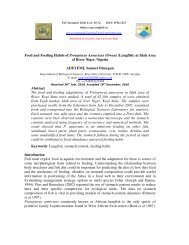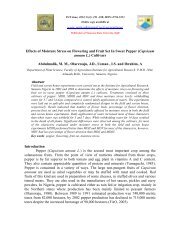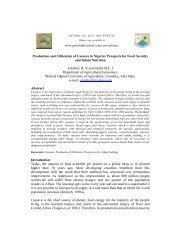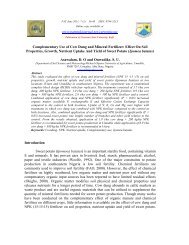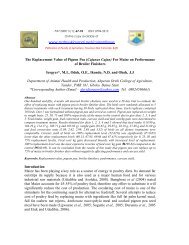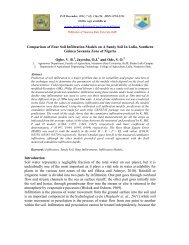View Publication - Production Agriculture and Technology Journal
View Publication - Production Agriculture and Technology Journal
View Publication - Production Agriculture and Technology Journal
Create successful ePaper yourself
Turn your PDF publications into a flip-book with our unique Google optimized e-Paper software.
PAT 2012; 8 (2): 76-87 ISSN: 0794-5213; Atungwu et al: Novel Organic Fertilizers For Management ….… 78Materials <strong>and</strong> MethodsA screenhouse experiment was conducted in 2008, <strong>and</strong> repeated in 2009 at theUniversity of <strong>Agriculture</strong>, Abeokuta, Nigeria. Three novel organic fertilizers were usednamely, Sunshine organic fertilizer, Neem fertilizer, <strong>and</strong> IAR & T fertilizer. They wereapplied in soil in quantities of 40 g each per 4 kg of s<strong>and</strong>y loam topsoil which had beenheat-sterilised at 65 o C for 1.5 hr. Overall; 4 kg of soil were used per 6-litre pot. Thesoil was homogeneously mixed with 1 % w/w of each of the organic fertilizer 14 daysprior to planting. Pots that received no organic fertilizer served as control. The bottomsof the pots were perforated to allow drainage of excess water during daily watering.Physiochemical properties of the soils were determined (Table 1) using routinemethods such as flame photometer <strong>and</strong> Kjeldahl analytical procedure. Soybean variety,TGx1019-2EN was the study crop <strong>and</strong> seeds were sourced from the InternationalInstitute for Tropical <strong>Agriculture</strong> (IITA) at Ibadan in Nigeria. Proximate compositionsof the organic fertilizers are presented in Table 2.Treatments include:a) Control: TGx 1019-2EN inoculated with Meloidogyne incognita + no fertilizer ;b) TGx 1019-2EN inoculated with Meloidogyne incognita + sunshine fertilizer ;c) TGx 1019-2EN inoculated with Meloidogyne incognita + IAR& T fertilizer; <strong>and</strong>d) TGx 1019-2EN inoculated with Meloidogyne incognita + neem fertilizer .Treatments were laid out in completely r<strong>and</strong>omised design with six replications. Theseeded pots were watered daily. Each pot was made to support one soybean plantInoculation of soybean seedlingsPure culture of M. incognita previously maintained on susceptible Celosiaargentea variety, TLV 8 obtained from the National Horticultural Research Institute atIbadan in Nigeria, was used for inoculating soybean seedlings. Eggs were extractedfrom eight weeks old highly galled C. argentea roots, using 0.52% active ingredient(a.i.) sodium hypochlorite (NaOCl) method (Hussey <strong>and</strong> Barker, 1973). Duringextraction, washed galled roots of C. argentea were cut into 12 cm pieces <strong>and</strong> placedin a 200 ml of 0.52 % a.i NaOCl at the ratio of 1:3 in a 500 ml capacity conical flask.Then it was tightly corked <strong>and</strong> shaken manually but vigorously for three minutes todissolve the gelatinous matrix enclosing the egg masses. The suspension containing theeggs was quickly poured over a 200-mesh sieve, s<strong>and</strong>wiched upon a 500-mesh sieve inwhich the eggs were caught. The 500- mesh sieve containing the eggs. was quicklyplaced under a gentle stream of cool tap water to rinse off residual of NaOCl. Therinsed M. incognita eggs were poured into a beaker after rinsing the 500-mesh sieve.Egg suspension was adjusted to 400 ml <strong>and</strong> calibrated by pipetting out 1 ml aliquot intoa Doncaster (1962) ringed counting dish <strong>and</strong> the eggs were estimated under astereomicroscope in the laboratory.
PAT 2012; 8 (2): 76-87 ISSN: 0794-5213; Atungwu et al: Novel Organic Fertilizers For Management ….… 79Each seedling was inoculated with 5,000 eggs of the nematode, one week afteremergence. Inoculation was done by pouring suspension containing 5,000 eggs of M.incognita into a shallow circular trench around the base of the seedling (Iheukwumereet al., 1995). The trench was covered with small quantity of the topsoil after which itwas wet lightly <strong>and</strong> daily afterwards.Data collection <strong>and</strong> analysisData were obtained on plant height, stem girth <strong>and</strong> number of branches at 4 <strong>and</strong>8 weeks after inoculation. Sixty days after inoculation, destructive plant sampling wasdone in 3 out of the 6 replicates per treatment to determine the number of galls <strong>and</strong> toestimate nematode reproduction ability. To achieve this, M. incognita eggs wereextracted from soybean roots using Hussey <strong>and</strong> Barker (1973) sodium hypochlorite (1%) method earlier described. Adult nematodes were extracted from the soil usingWhitehead <strong>and</strong> Hemming (1965) method. The summation of the nematode eggs <strong>and</strong>adults produced the final nematode population, which was divided by the initial 5,000egg population to estimate the reproduction potentials of the nematode.Data collected were subjected to analysis of variance (ANOVA) using SAS(2000) software. Significantly different treatment means were separated using FishersLeast Significant Difference (LSD 0.05 ).Results <strong>and</strong> DiscussionData for the effect of the study of organic fertilizers on key growth parametersof soybean grown in M. incognita infested soil are presented in Table 3. All the organicfertilizers had statistically significant (P < 0.05) positive influences on the growth <strong>and</strong>stem girths of soybean plants. Plant height ranged from 47.74 to 66.90 cm in fertilizertreatedplants at four weeks after inoculation (WAI), to 85.98 to 103.00 cm 8WAI in2008. These growth responses were significantly (P
PAT 2012; 8 (2): 76-87 ISSN: 0794-5213; Atungwu et al: Novel Organic Fertilizers For Management ….… 80the rhizosphere of the soybean plants significantly (p = 0.05) lowered the severity of theroot-knot disease from 86 galls per plant in control treatment to 1 5 galls per plantobserved in roots of organic fertilizer-treated TGx 1019 soybean variety. This meansthat the fertilizers tested in this experiment suppressed root-knot disease by 94 99 %.Neem gave the highest reduction in Mi nematode population <strong>and</strong> it subsequent damageon the soybean plants evaluated. The 2008 results were in concurrence with the 2010observations.The role played by the three organic fertilizers in suppressing southern root-knotnematode M. incognita population vis-à-vis reduction in plant damage by the invadingnematodes could be directly linked to the marked increases in yield <strong>and</strong> yieldcomponents (Table 5) of the inoculated soybean plants grown in organic fertilizeramendedsoil. Number of branches, pods <strong>and</strong> seeds per soybean plant variedsignificantly (p = 0.05) between amended soil <strong>and</strong> their control counterparts both in2008 <strong>and</strong> 2010 experiments. There were 77 86 %, 64 71 %, 90 106 % <strong>and</strong> 86 100 % higher pods, seeds, pod weight <strong>and</strong> seed weight per plant respectively insoybeans plants that received organic fertilizer application compared to untreated plantsobserved in 2008. Similar results were documented when the experiment was repeatedin 2010. These statistics follow the same pattern observed by previous findings(Atungwu <strong>and</strong> Lawal, 2008; Atungwu <strong>and</strong> Kehinde, 2008, Atungwu et al., 2009b) .Correlation studies presented on Table 6 relates some soybean growth indiceswith root galling <strong>and</strong> Mi infection indices. Correlation coefficients (r) were generallynegative but insignificant between root galls <strong>and</strong> plant height <strong>and</strong> stem girthsirrespective of the year of the experiment was conducted. This implied that gallinitiation was sufficiently inhibited to such an extent that less root-knot disease severitywas observed which did not warrant stunted growth that is usually characteristic of TGx1019-2EN being an Mi-susceptible soybean variety. Consequently, the relationshipbetween root gall <strong>and</strong> seed production was positive <strong>and</strong> significant in 2008 ( r = 0.59)<strong>and</strong> 2010 (r = 0.57)Soil amendment with different types of organic fertilizers caused significantreduction in populations of root-knot nematodes <strong>and</strong> their damage thus resulting inenhanced tolerance to Mi <strong>and</strong> subsequent improved yields of the soybean. This findingis in agreement with several previous workers reports (Kaplan <strong>and</strong> Noe, 1993; Sharmaet al., 1997; Verma et al., 1997; DAddabbo et al., 2000). Akhtar <strong>and</strong> Mahmood (1986)<strong>and</strong> Rodriguez-Kabana (1986) found that organic amendment with composted manure,oil cast of neem (Azadirachta indica), <strong>and</strong> castor (Ricinus cummunis) were potent inreducing populations of phytonematodes due to their low C:N ratio (6-10) <strong>and</strong> highammonium nitrogen content. Our findings in this present work particularly in neemfertilizer-treated plots showed significant reduction of the in the number of M. incognita
PAT 2012; 8 (2): 76-87 ISSN: 0794-5213; Atungwu et al: Novel Organic Fertilizers For Management ….… 83Symposium on the Biology <strong>and</strong> Control of Nematode Pests of Food Crops inAfrica. Pp 155 - 173Hussey, R. S. <strong>and</strong> K. R. Barker. 1973. A comparison of methods of collecting inoculafor Meloidogyne spp., including a new technique. Plant Disease Reporter 57: 1025 1028.Iheukwumere, C. C., Atiri, G. I., Fawole, B., <strong>and</strong> Dashiell, K. E. 1995. Evaluation ofsome commonly grown soybean cultivars for resistance to root-knot nematode<strong>and</strong> soybean mosaic virus in Nigeria. Fitopatol. Bras. 20: 190 193.Kaplan, M. <strong>and</strong> Noe, J. P. 1993. Effects of chicken excrement amendments onMeloidogyne arenaria. <strong>Journal</strong> of Nematology 25: 71 77Rodriguez-Kabana, R. 1986. Organic <strong>and</strong> inorganic amendments to soil as nematodesuppressants. <strong>Journal</strong> of Nematology 18: 129 135Sharma, S. K. Sharma., Sharma, G. L., <strong>and</strong> Baheti, B. L. 1997. Management of rootknotnematode Meloidogyne incognita on tomato through soil amendment withvarious composts. Indian <strong>Journal</strong> of Nematology 26: 263 265Verma, R. D., Mahendra, S., Samar, R., <strong>and</strong> Sharma, G. L. 1997. Effect of soilamendment against root-knot nematode Meloidogyne incognita on bottlegourd.Indian <strong>Journal</strong> of Nematology 27: 255 256Yudelman, M.A. Ratta <strong>and</strong> Nygaard, D.1998. Pest Management <strong>and</strong> Food <strong>Production</strong>:Looking to the futureWhitehead, A.G. <strong>and</strong> Hemming, J.R. 1965. A comparison of some quantitative methodsof extracting small vermiform nematodes from soil. Annals of Applied Boilogy55:25-38.
PAT 2012; 8 (2): 76-87 ISSN: 0794-5213; Atungwu et al: Novel Organic Fertilizers For Management ….… 84Table 1.Physiochemical properties of the of the soil used for the experimentsParametersProportionate valueExperiment IExperiment IIpH (H 2 O) 5.8 5.6% Organic Carbon 0.86 0.89% Organic matter 1.59 1.60Total N (%) 0.16 0.19Available P (%) 7.2 8.1Na Cmol/kg 0.66 0.63Exchangeable bases (c mol kg -1 )K 0.23 0.21Mg 0.82 0.79Ca 0.89 0.91C.E.C 2.79 2.81Physical properties (cmol kg -1 )Silt (%) 13.00 12.92Clay (%) 6.19 6.21S<strong>and</strong> (%) 89.01 89.07Textural class S<strong>and</strong>y loam S<strong>and</strong>y loamTable 2. Macro nutrient constituents of the three organic fertilizers used for the studyOrganic Fertilizer Nitrogen (%) Phosphorus (%) Potassium (%)Sunshine Fertilizer 3.50 1.00 1.20IAR&T Fertilizer 1.28 0.96 0.36Neem Fertilizer 7.00 7.00 6.00
PAT 2012; 8 (2): 76-87 ISSN: 0794-5213; Atungwu et al: Novel Organic Fertilizers For Management ….… 85Table 3. Effect of three novel organic fertilizers on growth parameters of nematodeMeloidogyneincognita-infected TGx 1019-2EN soybean varietyTreatment Plant Height (cm)4WAIPlant Height(cm) 8WAIStem girth (cm)4WAIStem girth(cm) 8WAIExperiment I (2008)Control 30.42 62.80 0.48 0.58Sunshine66.90 103.00 0.53 0.81FertilizerIAR&T Fertilizer 65.03 100.67 0.53 0.73Neem Feriliser 28.60 77.25 0.36 0.64Treatment mean 47.74 85.98 0.48 0.69LSD (0.05) 20.80 39.23 0.10 0.17Experiment II (2009)Control 34.13 52.31 0.45 0.60Sunshine68.17 112.21 0.53 0.90FertilizerIAR&T Fertilizer 66.51 112.57 0.51 0.74Neem Feriliser 32.53 71.31 0.37 0.71Treatment mean 50.34 87.10 0.47 0.74LSD (0.05) 20.15 35.35 0.11 0.19Table 4. Effect of three novel organic fertilizers on nematode Meloidogyne incognitapopulations in TGx 1019-2EN soybean varietyTreatmentNo. of gallsper plantMeloidogyneincognita eggs/J2populationsrecovered perplantNo. ofMeloidogyneincognita adultsrecovered fromthe soilFinalpopulation ofMeloidogyneincognita perplantNematodereproductionFactor (Finalpopulation/5000Experiment I (2008)Control 85.53 6,781 471 7,252 1.45Sunshine Fertilizer 4.65 79 46 125 0.03IAR&T Fertilizer 5.41 81 35 116 0.02Neem Feritiser 1.21 35 12 47 0.01Treatment mean 24.2 1,744 141 1,885 0.38LSD (0.05) 28.11 2,901.5 190.1 3,207 0.61Experiment II (2009)Control 78.21 5,509 511 6,020 1.20Sunshine Fertilizer 5.34 73 35 108 0.02IAR&T Fertilizer 5.93 91 41 132 0.03Neem Feriliser 1.65 37 15 52 0.01Treatment mean 22.78 1,427.5 150.5 1,578 0.32LSD (0.05) 27.22 2,115.8 193.3 2,998 0.05
PAT 2012; 8 (2): 76-87 ISSN: 0794-5213; Atungwu et al: Novel Organic Fertilizers For Management ….… 86Table 5: Effect of three novel organic fertilizers on yield components of soybean varietyinoculated with Meloidogyne incognitaTreatmentNo. ofbranchesper plantNo. ofpods perplantNo. ofseedsperPod weight(g/plant )Seedweight(g/plant)plantExperiment I (2008)Control 3 22 42 8.18 5.11Sunshine Fertilizer 3 41 69 16.82 10.06IAR&T Fertilizer 3 39 71 15.74 10.20Neem Feriliser 1 39 72 15.52 9.50Treatment mean 2.50 35.25 63.50 14.07 8.72LSD (0.05) 2 12 26 6.40 1.05Experiment II (2009)Control 2 21 42 7.14 6.81Sunshine Fertilizer 3 44 87 14.45 10.12IAR&T Fertilizer 3 41 85 14.53 10.17Neem Feriliser 2 38 71 8.52 9.51Treatment mean 2.50 36 71.25 11.16 9.15LSD (0.05) 2 13 23 6.13 1.19
PAT 2012; 8 (2): 76-87 ISSN: 0794-5213; Atungwu et al: Novel Organic Fertilizers For Management ….… 87ParameterTable 6. Correlation among growth indices of Meloidogyne incognita-inoculated TGx1019-2EN soybean varietyPlantht(cm)StemGirth(cm)GallNo.Eggs/J2SoilPopulationFinalPopulationRFactor Pod No. SeedNo.Experiment I (2008)Plant ht (cm) 1.00Stem Girth (cm) 0.52 1.00Gall No. -0.48 -0.36 1.00Eggs/J2 -0.56* -0.22 0.73** 1.00Soil Population -0.12 -0.02 0.59* 0.76** 1.00Final Population -0.29 -0.06 0.68* 0.90** 0.97** 1.00RFactor -0.30 -0.06 0.68* 0.90** 0.96** 0.99* 1.00Pod No. 0.40 0.24 0.39 0.58* 0.48 0.55 0.55 1.00Seed No. 0.49 0.28 -0.59* 0.73* 0.50 0.62* 0.62* 0.93** 1.00Pod wt 0.52 0.29 0.42 0.53 0.25 0.37 0.38 0.87** 0.91** 1.00Seed wt 0.50 0.28 0.35 0.41 0.11 0.22 0.23 0.79** 0.83** 0.98** 1.00Experiment II (2009)Plant ht (cm) 1.00Stem Girth (cm) 0.52 1.00Gall No. -0.47 -0.42 1.00Eggs/J2 -0.54* -0.21 0.71** 1.00Soil Population -0.21 -0.12 0.57* 0.81** 1.00Final Population -0.31 -0.04 0.59* 0.88** 0.86** 1.00RFactor -0.29 -0.05 0.57* 0.95** 0.87** 0.91** 1.00Pod No. 0.39 0.26 0.36 0.66* 0.46 0.45 0.44 1.00Seed No. 0.45 0.29 -0.57* 0.69* 0.49 0.65* 0.65* 0.91** 1.00Pod wt 0.51 0.31 0.41 0.51 0.30 0.35 0.39 0.89** 0.89** 1.00Seed wt 0.49 0.24 0.39 0.37 0.18 0.29 0.15 0.81** 0.91** 0.93** 1.00* Significant at 5 % level of probability ** Significant at 1 % level of probabilityPod wtSeedwt



